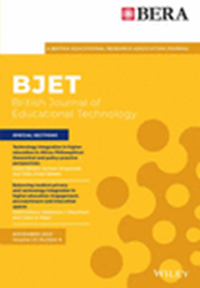在 STEM+C 学习环境中支持教师、研究人员和人工智能协作的多模式方法
摘要
生成式人工智能(AI)和多模态学习分析(MMLA)的最新进展,为利用人工智能支持 K12 学生在 STEM+C 领域的协作学习提供了新的创造性方法。迄今为止,几乎没有证据表明人工智能方法能够支持学生在复杂的开放式环境中开展协作。众所周知,人工智能系统在以下方面的表现不如人类:(1)解读学生在学习情境中的情绪;(2)把握社会互动的细微差别;(3)理解训练数据中未充分反映的特定领域信息。因此,需要结合人类和人工智能(即混合)的方法来克服人工智能系统目前的局限性。在本文中,我们迈出了第一步,研究教师和研究人员之间的人机协作如何利用人工智能生成的多模态时间轴来指导和支持教师的反馈,同时解决学生在协作建立计算模型和解决问题时遇到的 STEM+C 困难。为此,我们提出了一个框架,将人与人工智能合作中的人类部分描述为教师与研究人员之间的合作。为了评估我们的方法,我们向一位高中教师展示了我们的时间轴,并讨论了从我们的讨论中获得的关键见解。我们的案例研究分析揭示了利用人类-人工智能合作解决学生 STEM+C 挑战的迭代方法的有效性:教师可以使用人工智能生成的时间轴来指导学生的形成性反馈,而研究人员可以利用教师的反馈来帮助改进多模态时间轴。此外,我们还就教师感兴趣的两个事件描述了我们的研究结果:(1) 学生何时越过难度阈值;(2) 干预点,即教师(或系统)应何时进行干预以提供有效反馈。值得注意的是,教师解释说,在(1)和(2)之间应该有一个滞后期,让学生有机会自己解决困难。通常情况下,在提供反馈的计算机学习环境中不会有这样的滞后。 关于本主题的已知内容 合作式、开放式的学习环境可以增强学生对 STEM+C 概念的理解和练习,但当学生学习跨越多个领域的概念时,它们会带来额外的复杂性。生成式人工智能和 MMLA 的最新进展允许整合多个数据流以获得学生状态的整体视图,这可以支持更明智的反馈机制,以解决学生在复杂的 STEM+C 环境中遇到的困难。人类-人工智能混合方法将人类专家的领域知识、情商和社会意识与人工智能的常识和效率相结合,有助于解决学生在 STEM+C 学习中遇到的困难。本文的补充 我们使用混合智能方法扩展了之前的人类-人工智能合作框架,将合作关系中的人类部分描述为研究人员-教师合作关系,并将我们的方法描述为教师-研究人员-人工智能合作关系。我们将人工智能生成的多模态时间轴与学生遇到困难的视频配对,以实现人与人工智能的合作,并在观看视频的同时与一名高中教师进行积极讨论,以了解时间轴在课堂上的实用性。通过与教师的讨论,我们定义了两种类型的拐点来解决学生在 STEM+C 方面遇到的困难--困难阈值和干预点,并讨论了两者之间的反馈延迟时间间隔如何为教育工作者的干预措施提供信息。我们讨论了教师-研究人员-人工智能合作帮助教师为遇到 STEM+C 困难的学生提供支持的两种方式:(1)教师使用多模态时间轴指导对学生的反馈;(2)研究人员利用教师的意见迭代完善多模态时间轴。对实践和/或政策的影响 我们的案例研究表明,时间轴间隙(即屏幕外学生发现的脱离行为、话语中的停顿和环境行动中的停顿)对于识别拐点和制定形成性反馈尤为重要。人类与人工智能的协作存在于一个动态范围内,需要不同程度的人类控制和人工智能自动化,具体取决于学习任务的背景和学生在环境中的工作情况。我们利用多模态时间轴对这种人类-人工智能协作进行的分析可在未来扩展到以更多方式为学生和教师提供支持,例如,设计与学生直接互动的教学代理、为教师开发干预和反思工具、帮助教师精心制作日常课程计划以及协助教师和管理人员设计课程。




Recent advances in generative artificial intelligence (AI) and multimodal learning analytics (MMLA) have allowed for new and creative ways of leveraging AI to support K12 students' collaborative learning in STEM+C domains. To date, there is little evidence of AI methods supporting students' collaboration in complex, open-ended environments. AI systems are known to underperform humans in (1) interpreting students' emotions in learning contexts, (2) grasping the nuances of social interactions and (3) understanding domain-specific information that was not well-represented in the training data. As such, combined human and AI (ie, hybrid) approaches are needed to overcome the current limitations of AI systems. In this paper, we take a first step towards investigating how a human-AI collaboration between teachers and researchers using an AI-generated multimodal timeline can guide and support teachers' feedback while addressing students' STEM+C difficulties as they work collaboratively to build computational models and solve problems. In doing so, we present a framework characterizing the human component of our human-AI partnership as a collaboration between teachers and researchers. To evaluate our approach, we present our timeline to a high school teacher and discuss the key insights gleaned from our discussions. Our case study analysis reveals the effectiveness of an iterative approach to using human-AI collaboration to address students' STEM+C challenges: the teacher can use the AI-generated timeline to guide formative feedback for students, and the researchers can leverage the teacher's feedback to help improve the multimodal timeline. Additionally, we characterize our findings with respect to two events of interest to the teacher: (1) when the students cross a difficulty threshold, and (2) the point of intervention, that is, when the teacher (or system) should intervene to provide effective feedback. It is important to note that the teacher explained that there should be a lag between (1) and (2) to give students a chance to resolve their own difficulties. Typically, such a lag is not implemented in computer-based learning environments that provide feedback.
Practitioner notes
What is already known about this topic
- Collaborative, open-ended learning environments enhance students' STEM+C conceptual understanding and practice, but they introduce additional complexities when students learn concepts spanning multiple domains.
- Recent advances in generative AI and MMLA allow for integrating multiple datastreams to derive holistic views of students' states, which can support more informed feedback mechanisms to address students' difficulties in complex STEM+C environments.
- Hybrid human-AI approaches can help address collaborating students' STEM+C difficulties by combining the domain knowledge, emotional intelligence and social awareness of human experts with the general knowledge and efficiency of AI.
What this paper adds
- We extend a previous human-AI collaboration framework using a hybrid intelligence approach to characterize the human component of the partnership as a researcher-teacher partnership and present our approach as a teacher-researcher-AI collaboration.
- We adapt an AI-generated multimodal timeline to actualize our human-AI collaboration by pairing the timeline with videos of students encountering difficulties, engaging in active discussions with a high school teacher while watching the videos to discern the timeline's utility in the classroom.
- From our discussions with the teacher, we define two types of inflection points to address students' STEM+C difficulties—the difficulty threshold and the intervention point—and discuss how the feedback latency interval separating them can inform educator interventions.
- We discuss two ways in which our teacher-researcher-AI collaboration can help teachers support students encountering STEM+C difficulties: (1) teachers using the multimodal timeline to guide feedback for students, and (2) researchers using teachers' input to iteratively refine the multimodal timeline.
Implications for practice and/or policy
- Our case study suggests that timeline gaps (ie, disengaged behaviour identified by off-screen students, pauses in discourse and lulls in environment actions) are particularly important for identifying inflection points and formulating formative feedback.
- Human-AI collaboration exists on a dynamic spectrum and requires varying degrees of human control and AI automation depending on the context of the learning task and students' work in the environment.
- Our analysis of this human-AI collaboration using a multimodal timeline can be extended in the future to support students and teachers in additional ways, for example, designing pedagogical agents that interact directly with students, developing intervention and reflection tools for teachers, helping teachers craft daily lesson plans and aiding teachers and administrators in designing curricula.

 求助内容:
求助内容: 应助结果提醒方式:
应助结果提醒方式:


